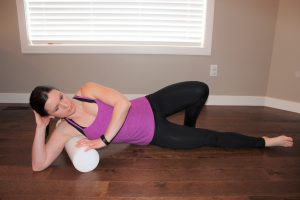This week’s installment of Strength in Knowledge is Part 3 of a 3-part series on foam rolling. Part 1 discussed the theory behind foam rolling. Part 2 covered how to safely foam roll. This final installment will highlight a few popular foam rolling techniques.
Disclaimer: Please ensure that you have read Part 2 of the 3-part series on foam rolling prior to trying these techniques. Part 2 was featured in The Leduc Rep and can also be found online at rxphysiotherapy.com/blog
Additionally, if you are unsure if foam rolling is right for you, if you have osteoporosis, difficulty getting on and off of the floor independently, or have sustained a recent injury, please consult with a healthcare professional before trying these.
Quadriceps (Front of Thighs)
Roll the front of your thighs from the crease of your hip down to (but NOT over) your kneecaps. You can do both legs at once, or for more pressure, you can cross over at the ankle and just roll one at a time (as shown). Remember to keep breathing and sink into the foam roller as you roll slowly back and forth for 1-2 minutes.

Glute med and min (Upper side of Buttock)
Roll the side of your buttock (glute med and min) from just above the hip bone to the top of the pelvic bone. Take care NOT to roll over the hip bone (located at the widest part of your hips) to avoid rolling over the trochanteric bursa that resides there.

Lat dorsi and posterior shoulder (the back border of your armpit)
Roll the muscles that make up the back border of your armpit (the lats and posterior shoulder muscles) which can wreck havoc on the shoulder girdle. You can do this with your elbow bent or straight – whichever is more comfortable.

These are just a few of the techniques that utilize a foam roller. There are several more, in addition to many other self myofascial release options using other myofascial tools such as spiky balls, Yoga Tune Up balls, Pilates balls, hand held rollers and more. Patient instruction in these techniques, when appropriate, is one of the many services provided to empower our patients at RX Physiotherapy. Get in touch if you want to learn more!
Teresa Waser is a physiotherapist and owner of RX Physiotherapy. She has a Master of Science in Physical Therapy from the University of Alberta, in addition to several years of continuing education and experience treating patients of all ages. Outside of the clinic, she coaches running and CrossFit and is passionate about helping others live life to the fullest. You can find more about Teresa and how she can help you at rxphysiotherapy.com
